
Wissahickon Creek is a tributary of the Schuylkill River in Montgomery and Philadelphia Counties, Pennsylvania.
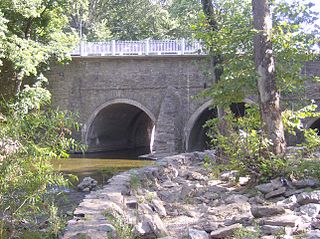
Pennypack Creek is a 22.6-mile-long (36.4 km) creek in southeastern Pennsylvania in the United States. It runs southeast through lower Bucks County, eastern Montgomery County and the northeast section of Philadelphia, before emptying into the Delaware River.

Poquessing Creek is a 10.3-mile-long (16.6 km) creek, a right tributary of the Delaware River, that forms the boundary between Philadelphia and Bensalem Township, which borders it to the northeast along the Delaware. It has defined this boundary between Bucks and Philadelphia counties since 1682.
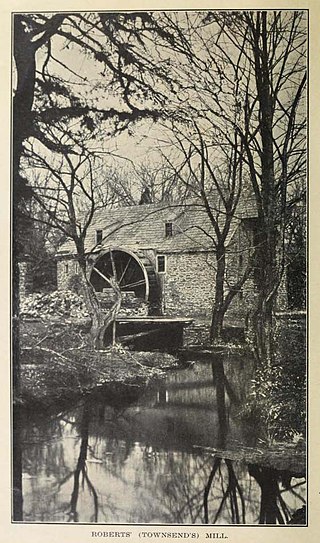
Wingohocking Creek was once a major tributary of another Philadelphia, Pennsylvania stream, Frankford Creek, which flows into the Delaware River. Frankford Creek was formed by the confluence of Wingohocking Creek and Tacony Creek. Since Wingohocking Creek is now obliterated, having been piped underground in the late 19th century, it can be confusing to look at a modern map, which shows Tacony Creek suddenly changing names "in the middle of the stream," so to speak, and becoming Frankford Creek. The point at which the name changes is near the present intersection of I and Ramona Streets, where the Wingohocking once joined the Tacony to form the Frankford Creek. What was once a major stream and the site of many mills and factories has been completely wiped off the map—all but the city's sewer maps, that is. The outlet of the Wingohocking Sewer is the largest in the Philadelphia sewer system, about 24 feet (7.3 m) high. It is visible from various points in the Juniata neighborhood and the adjoining golf course.
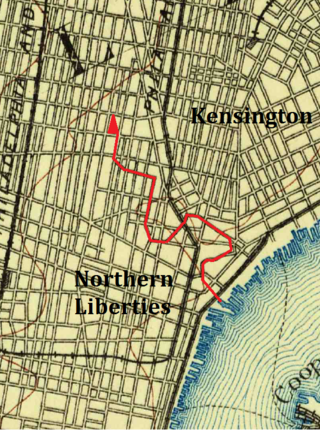
The Cohocksink Creek was formerly a stream running between what are now the Philadelphia neighborhoods of Northern Liberties and Kensington. It was a tributary of the Delaware River. Its name, spelled various ways, is said to come from a Lenape word for "pine lands". Alternate names included Stacey's Creek. The creek arose at the confluence of two smaller streams in a pond around the present-day intersection of Sixth and Thompson streets. For centuries, Cohocksink Creek has often been confused with Cohoquinoque Creek, a culverted stream about a mile to the south.

Chester Creek is a 9.4-mile-long (15.1 km) tributary of the Delaware River in Delaware County, Pennsylvania in the United States.

Ridley Creek is a tributary of the Delaware River in Chester and Delaware counties, Pennsylvania in the United States.
Meshoppen Creek is a tributary of the Susquehanna River in Susquehanna and Wyoming counties, Pennsylvania, in the United States. It is approximately 30.6 miles (49.2 km) long and flows through Bridgewater Township, Dimock Township, and Springville Township in Susquehanna County and Lemon Township, Washington Township, Meshoppen Township, and Meshoppen in Wyoming County. The watershed of the creek has an area of 114 square miles (300 km2). It is possible to canoe on 17.0 miles (27.4 km) of Meshoppen Creek.

Catawissa Creek is a 41.8-mile-long (67.3 km) tributary of the Susquehanna River in east-central Pennsylvania in the United States. Its watershed has an area of 153 square miles (400 km2).

Rock Creek is an 18.9-mile-long (30.4 km) tributary of the Monocacy River in south-central Pennsylvania and serves as the border between Cumberland and Mount Joy townships. Rock Creek was used by the Underground Railroad and flows near several Gettysburg Battlefield sites, including Culp's Hill, the Benner Hill artillery location, and Barlow Knoll.

Little Fishing Creek is a tributary of Fishing Creek in Sullivan County, Lycoming County, and Columbia County, in Pennsylvania, in the United States. It is approximately 23.5 miles (37.8 km) long and flows through eight townships. The watershed of the creek has an area of 68.1 square miles (176 km2). The creek has six named tributaries, of which the largest are Spruce Run and West Branch Run.

Ithan Creek is a tributary of Darby Creek in Delaware County, Pennsylvania, in the United States. It is approximately 4.2 miles (6.8 km) long and flows through Radnor Township and Haverford Township. The creek's watershed has an area of 7.39 square miles (19.1 km2) and is highly developed. It has three named tributaries: Browns Run, Kirks Run, and Meadowbrook Run.

Roaring Creek is a tributary of the Susquehanna River in Columbia County and Montour County, in Pennsylvania, in the United States. It is slightly more than 20 miles (32 km) long and flows through Roaring Creek Township, Locust Township, Catawissa Township, Cleveland Township, and Franklin Township in Columbia County and Mayberry Township in Montour County. The watershed of the creek has an area of 87.3 square miles (226 km2). It has three named tributaries: South Branch Roaring Creek, Lick Run, and Mill Creek. The creek is not considered to be impaired and is not affected by coal mining. However, its watershed has been impacted by human land use. Claystones, conglomerates, sandstones, siltstones, and shales all occur within the watershed. The creek flows through a gorge in its lower reaches, along the border between Columbia County and Montour County.
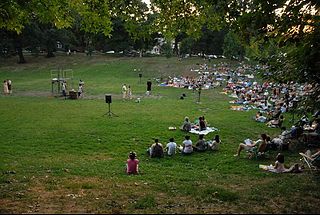
Mill Creek rises in Montgomery County, Pennsylvania; runs southeasterly to West Philadelphia, where it enters 19th-century sewer pipes; and debouches roughly five miles later in the Schuylkill River near The Woodlands Cemetery. It starts near Narberth, where its source is buried, then runs free for a mile or so before entering Philadelphia at the Overbrook station.
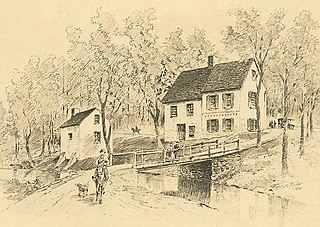
William Rittenhouse was an American papermaker and businessman. He served as an apprentice papermaker in the Netherlands and, after moving to the Pennsylvania Colony, established the first paper mill in the North American colonies, helping to meet the growing demand for paper among the Early American publishers and printers. Rittenhouse was also the first Mennonite bishop in America. Along with his two sons, and their descendants, the Rittenhouse family maintained a papermaking business in Pennsylvania for well over one hundred years. The site of the original mill is now preserved as the Historic RittenhouseTown district of Philadelphia.

Historic RittenhouseTown, sometimes referred to as Rittenhouse Historic District, encompasses the remains of an early industrial community which was the site of the first paper mill in British North America. The mill was built in 1690 by William Rittenhouse and his son Nicholas on the north bank of Paper Mill Run near Philadelphia, Pennsylvania. The district, off Lincoln Drive near Wissahickon Avenue in Fairmount Park, includes six of up to forty-five original buildings. RittenhouseTown was listed on the National Register of Historic Places and was designated a National Historic Landmark District on April 27, 1992.
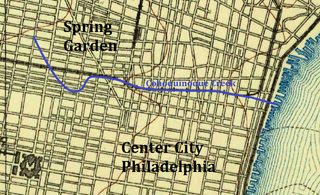
The Cohoquinoque Creek was formerly a stream running west to east through the Callowhill neighborhood in Philadelphia, along the southern part of Northern Liberties and immediately north of original northern boundary of Philadelphia. This small tributary of the Delaware River remains today, as a sewer, under Willow Street, which winds its way through what is sometimes called the East Callowhill Industrial District. Its name, spelled various ways, is said to be derived from a Lenni-Lenape word for "the grove of long pine trees." This was also the name of a nearby Lenape village.
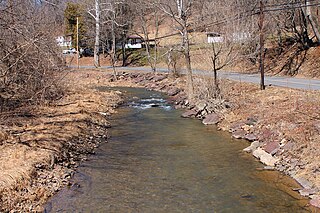
Hemlock Creek is a stream in Columbia County, Pennsylvania, in the United States. It is 7.6 miles (12.2 km) in length. The stream is a tributary of Fishing Creek. It is primarily in Madison and Hemlock Townships. Its named tributaries are West Hemlock Creek and Frozen Run. Hemlock Creek flows through Montour Ridge. Industries in the vicinity of Hemlock Creek have largely consisted of mills and iron mines. The creek's watershed is in Columbia and Montour Counties and is 16 square miles (41 km2) in area.

Dock Creek was a stream draining much of what is now the eastern half of Center City, Philadelphia. It was a tributary of the Delaware River. By 1820, the entire creek had been covered and converted to a sewer. The present-day Dock Street follows the lower course of the stream.

Lincoln Drive is a 4.1 mile road in the Wissahickon Creek section of Philadelphia, Pennsylvania. Initially built in 1856 as the Wissahickon Turnpike, it was not completed until about 50 years later. The road is called the “Dead Man’s Gulch” due to its twisting and turning. Initially, the purpose of the road was to provide access from the mills to the city of Philadelphia.



















